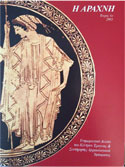November's word: Peplos
The peplos is the thick, women’s garment, usually of wool, and often worn over the chiton. It has been established as a typical women’s garment in ancient Greece around 500 BC, initially as Doric dress. It is made from a rectangular piece of cloth, folded in the middle and open in one side. First, it is folded horizontally, in a way that the top piece (apoptygma) falls over the garment and then it is wrapped around the body. It didn’t have seems or sleeves and was fastened at the shoulders with metal pins and brooches. The folded piece had the appearance of a second garment. It was often worn with a girdle creating many visible folds.
The statues of the Caryatids present a typical peplos (also statues of Athena and Artemis). From a simple dress, the peplos could of course be transformed to an elegant and rich garment via adequate embellishments, such as dyes, embroideries or woven decorations. Such a luxurious garment was surely the peplos of Athena, offered to the goddess during the Panathenaic Festival.
It is here interesting to note that, as the garment itself has pleats, plis in French, hence plissé, pleated, so does the term! It is reduplicated, pe-plos, in the same way as de-n-dron, like the Perfect tense, le-ly-ka. Its root is hard to retrieve (same as pleo, platys? – probably not; the one of pleko, plecto?), more likely something meaning “to form pleats”, “to fold”, probably the same root as in ha-ploos>aplous, di-ploos>diplous and as in the second component of lat. sim-plex, du-plex etc. According to Ernout and Meillet, plex<plek-< *ple-and the simpler *pel-. Maybe from *pleh1 (plur. –pleo) with the sense of cardinality, which can range from zero to a number understandable for the people of the prehistoric time, a couple of folds?
[The ha-, as well as sim-from *sn̥ that gave in Greek heis, hama etc.]. The very old term haplous, with the same meaning until now; in Homer haplois-idosis the outer garment thrown over the body unfolded.
The peplos has survived in the Greek language, from the classical one and the Panathenaic peplos, to the wedding veil, still called peplos today in Modern Greek.


